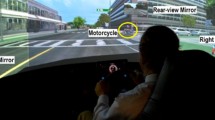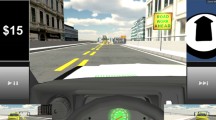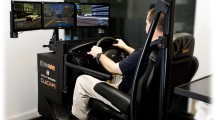Abstract
Previous studies have shown that individuals with autism spectrum disorder (ASD) demonstrate poorer driving performance than their peers and are less likely to obtain a driver’s license. This study aims to examine the relationship between driving performance and executive functioning for novice drivers, with and without ASD, using a driving simulator. Forty-four males (ages 15–23), 17 with ASD and 27 healthy controls, completed paradigms assessing driving skills and executive functioning. ASD drivers demonstrated poorer driving performance overall and the addition of a working memory task resulted in a significant decrement in their performance relative to control drivers. Results suggest that working memory may be a key mechanism underlying difficulties demonstrated by ASD drivers and provides insight for future intervention programs.


Similar content being viewed by others
References
Adler, L. A., Resnick, S., Kunz, M., & Devinsky, O. (1995). Open-label trial of venlafaxine in adults with attention deficit disorder. Psychopharmacology Bulletin, 31(4), 785–788.
American Psychiatric Association. (2000). Diagnostic and statistical manual of mental disorders (4th ed., text rev.). Washington, DC: American Psychiatric Publishing.
Banich, M. T. (2004). Cognitive neuroscience and neuropsychology. Houghton Mifflin College Division.
Brooks, J. O., Mossey, M. E., Collins, J. C., & Tyler, P. (2013). An exploratory investigation: Are driving simulators appropriate to teach pre-driving skills to young adults with intellectual disabilities? British Journal of Learning Disabilities, 42, 204–213.
Brouwer, W. H., Waterink, W., Van Wolffelaar, P. C., & Rothengatter, T. (1991). Divided attention in experienced young and older drivers: Lane tracking and visual analysis in a dynamic driving simulator. Human Factors: The Journal of the Human Factors and Ergonomics Society, 33(5), 573–582.
Bulmash, E. L., Moller, H. J., Kayumov, L., Shen, J., Wang, X., & Shapiro, C. M. (2006). Psychomotor disturbance in depression: Assessment using a driving simulator paradigm. Journal of Affective Disorders, 93, 213–218.
Classen, S., & Monahan, M. (2013). Evidence based review on interventions and determinants of driving performance in teens with attention deficit hyperactivity disorder or autism spectrum disorder. Traffic Injury Prevention, 14, 188–193.
Classen, S., Monahan, M., & Hernandez, S. (2013). Indicators of simulated driving skills in adolescents with autism spectrum disorder. The Open Journal of Occupational Therapy, 1(4), 2.
Cohen, G., & Conway, M. A. (Eds.). (2007). Memory in the real world. Hove, England: Psychology Press.
Constantino, J. N., & Gruber, C. P. (2002). The social responsiveness scale (SRS). Los Angeles: Western Psychological Services.
Constantino, J. N., & Gruber, C. P. (2012). The social responsiveness scale, 2nd edn (SRS-2). Los Angeles, CA: Western Psychological Services.
Conway, A. A., Kane, M. J., Bunting, M. F., Hambrick, D. Z., Wilhelm, O., & Engle, R. W. (2005). Working memory span tasks: A methodological review and user’s guide. Psychonomic Bulletin & Review, 12(5), 769–786.
Cox, A. B., & Cox, D. J. (1998). Senior’s compensatory driving strategy may increase driving risk. Journal of the American Geriatrics Society, 46(8), 1058–1060.
Cox, D. J., Taylor, P., & Kovatchev, B. (1999). Driving simulation performance predicts future accidents among older drivers. Journal of the American Geriatrics Society, 47(3), 381–382.
Cox, N. B., Reeve, R. E., Cox, S. M., & Cox, D. J. (2012). Brief report: Driving and young adults with ASD: Parents’ experiences. Journal of Autism and Developmental Disorders, 42(10), 2257–2262.
Cox, D. J., Moncrief, M., Rizzo, M., Fisher, D., Lambert, A., Thomas, S., et al. (2015). Low hanging fruit: Use of virtual reality simulation in Department of Motor Vehicles to assess minimal competence of novice drivers. In Paper presented at international driving symposium on human factors in driving assessment, training, and vehicle design, Salt Lake City, UT.
Dagenbach, D., & Carr, T. H. (1994). Inhibitory processes in perceptual recognition: Evidence for a center-surround attentional mechanism. San Diego, CA: Academic Press.
Dempster, F. N. (1992). The rise and fall of the inhibitory mechanism: Toward a unified theory of cognitive development and aging. Developmental Review, 12(1), 45–75.
Godley, S. T., Triggs, T. J., & Fildes, B. N. (2002). Driving simulator validation for speed research. Accident Analysis and Prevention, 34, 589–600.
Hill, E. L. (2004). Evaluating the theory of executive dysfunction in autism. Developmental Review, 24(2), 189–233.
Hoffman, J. D., Lee, J. D., Brown, T. L., & McGehee, D. V. (2002). Comparison of driver braking responses in a high-fidelity simulator and on a test track. Transportation Research Record: Journal of the Transportation Research Board, 1803(1), 59–65.
Huang, P., Kao, T., Curry, A. E., & Durbin, D. R. (2012). Factors associated with driving in teens with autism spectrum disorders. Journal of Developmental and Behavioral Pediatrics, 33(1), 70–74.
Kaptein, N. A., Theeuwes, J., & van der Horst, R. (1996). Driving simulator validity: Some considerations. Transportation Research Record, 1550, 30–36.
Kasper, L. J., Alderson, R. M., & Hudec, K. L. (2012). Moderators of working memory deficits in children with attention- deficit/hyperactivity disorder (ADHD): A meta-analytic review. Clinical Psychology Review,. doi:10.1016/j.cpr.2012.07.001.
Lambert, A. E., Cox, D. J., O’Connor, M. L., Cho, C., Johnson, R. J. (2013). Age differences in driving-specific tests of executive function. In Poster presented at the 7th international driving symposium on human factors in driver assessment, training and vehicle design the sagamore resort on Lake George in Bolton Landing, NY.
Lambert, A. E., Simons-Morton, B. G., Cain, S. A., Weisz, S., & Cox, D. J. (2014). Considerations of a dual-systems model of cognitive development and risky driving. Journal of Research on Adolescence, 24(3), 541–550.
Lee, H. C., Lee, A. H., Cameron, D., & Li-Tsang, C. (2003). Using a driving simulator to identify older drivers at inflated risk of motor vehicle crashes. Journal of Safety Research, 34(4), 453–459.
Lew, H. L., Poole, J. H., Lee, E. H., Jaffe, D. L., Huang, H. C., & Brodd, E. (2005). Predictive validity of driving-simulator assessments following traumatic brain injury: A preliminary study. Brain Injury, 19(3), 177–188.
Liss, M., Fein, D., Allen, D., Dunn, M., Feinstein, C., Morris, R., et al. (2001). Executive functioning in high-functioning children with autism. Journal of Child Psychology and Psychiatry, 42(2), 261–270.
Mäntylä, T., Karlsson, M. J., & Marklund, M. (2009). Executive control functions in simulated driving. Applied Neuropsychology, 16(1), 11–18. doi:10.1080/09084280802644086.
Miyake, A., Friedman, N. P., Emerson, M. J., Witzki, A. H., & Howerter, A. (2000). The unity and diversity of executive functions and their contributions to complex “frontal lobe” tasks: A latent variable analysis. Cognitive Psychology, 41, 49–100.
Monahan, M. (2012). Evaluating and treating adolescents with special needs. In M. J. McGuire & E. S. Davis (Eds.), Driving and community mobility: Occupational therapy strategies across the lifespan (pp. 383–410). Bethesda, MD: AOTA.
Mullen, N., Charlton, J., Devlin, A., & Bedard, M. (2011). Simulator validity: Behaviors observed on the simulator and on the road. In D. Fisher, M. Rizzo, J. Caird, & J. Lee (Eds.), Handbook of driving simulation for engineering, medicine, and psychology. Boca Raton, FL: CRC Press.
National Highway and Transportation Safety Administration. (2008). Traffic safety facts 2008 data: Older population. (NHTSA’s National Center for Statistics and Analysis). http://www-nrd.nhtsa.dot.gov/Pubs/811161.pdf.
Ozonoff, S., Pennington, B. F., & Rogers, S. J. (1991). Executive function deficits in high-functioning autistic individuals: Relationship to theory of mind. Journal of Child Psychology and Psychiatry, 32(7), 1081–1105.
Park, D. C. (2002). Aging, cognition, and culture: A neuroscientific perspective. Neuroscience and Biobehavioral Reviews, 26(7), 859–867.
Rapport, M. D., Orban, S. A., Kofler, M. J., & Friedman, L. M. (2013). Do programs designed to train working memory, other executive functions, and attention benefit children with ADHD? A meta-analytic review of cognitive, academic, and behavioral outcomes. Clinical Psychology Review, 33(8), 1237–1252.
Reimer, B., Fried, R., Mehler, B., Joshi, G., Bolfek, A., Godfrey, K. M., et al. (2013). Brief report: Examining driving behavior in young adults with high functioning autism spectrum disorders: A pilot study using a driving simulation paradigm. Journal of Autism and Developmental Disorders, 43(9), 2211–2217.
Reynolds, C. R., & Kamphaus, R. W. (2004). Behavior assessment system for children (2nd ed.). Bloomington, MN: Pearson Assessments.
Shechtman, O., Classen, S., Awadzi, K., & Mann, W. (2009). Comparison of driving errors between on-the-road and simulated driving assessment: A validation study. Traffic Injury Prevention, 10(4), 379–385.
Sheppard, E., Ropar, D., Underwood, G., & van Loon, E. (2010). Brief report: Driving hazard perception in autism. Journal of Autism and Developmental Disorders, 40(4), 504–508.
Shipstead, Z., Redick, T. S., & Engle, R. W. (2012). Is working memory training effective? Psychological Bulletin, 138(4), 628.
Snyder, H. R. (2013). Major depressive disorder is associated with broad impairments on neuropsychological measures of executive function: A meta-analysis and review. Psychological Bulletin, 139, 81–132.
Strayer, D. L., & Drew, F. A. (2004). Profiles in driver distraction: Effects of cell phone conversations on younger and older drivers. Human Factors: The Journal of the Human Factors and Ergonomics Society, 46(4), 640–649.
Underwood, G., Crundall, D., & Chapman, P. (2011). Driving simulator validation with hazard perception. Transportation research part F: Traffic psychology and behaviour, 14(6), 435–446.
Unsworth, N., Heitz, R. P., Schrock, J. C., & Engle, R. W. (2005). An automated version of the operation span task. Behavior Research Methods, 37, 498–505.
Vaa, T. (2014). ADHD and relative risk of accidents in road traffic: A meta-analysis. Accident Analysis and Prevention, 62, 415–425.
Watson, J. M., Lambert, A. E., Cooper, J. M., Boyle, I. V., & Strayer, D. L. (2013). On attentional control and the aging driver. In R. Zheng, R. Hill, & M. Gardner (Eds.), Engaging older adults with modern technology: Internet use and information access needs (pp. 20–32). Hershey, PA: Information Science Reference.
Willcutt, E. G., Doyle, A. E., Nigg, J. T., Faraone, S. V., & Pennington, B. F. (2005). Validity of the executive function theory of attention-deficit/hyperactivity disorder: A meta-analytic review. Biological Psychiatry, 57(11), 1336–1346.
Womack, J. L., & Silverstein, N. (2012). The big picture: Comprehensive community mobility options. In M. J. McGuire & E. Schold-Davis (Eds.), Driving and community mobility: Occupational therapy strategies across the lifespan (pp. 19–46). Bethesda, MD: AOTA Press.
Zelazo, P. D., Craik, F. I., & Booth, L. (2004). Executive function across the life span. Acta Psychologica, 115(2), 167–183.
Acknowledgments
The authors would like to thank the participants and parents/caregivers who participated in our study. We would like to acknowledge their time, commitment, energy, and insight, which were critical for our research. This research was supported by a Department of Defense Autism Pilot Project award W81XWH-11-1-0787.
Author Contributions
SMC participated in the design and coordination of the study, performed the clinical measures and collected data for the ASD group, participated in developing the dataset, performing statistical analysis, interpretation of the data, and drafted the manuscript; DC conceived of the study, participated in the design and interpretation of the data, and helped to draft the manuscript; MK participated in the design of the study, participated in statistical methods and interpretation of the data, and helped to draft the manuscript; MM participated in developing dataset, performing statistical analysis and interpretation of the data; AL participated in the design and coordination of the parallel study for healthy controls (HC), also administered clinical measures and participated in design and interpretation of HC data that was utilized for this manuscript; RJ participated in the coordination of both the ASD and HC studies and administered the driving simulator protocol to participants from both groups; SAC participated in the coordination of the ASD study and administered clinical measures for ASD participants; RR participated in the design and coordination of the study and helped to draft the manuscript. All authors read and approved the final manuscript.
Author information
Authors and Affiliations
Corresponding author
Electronic supplementary material
Below is the link to the electronic supplementary material.
Rights and permissions
About this article
Cite this article
Cox, S.M., Cox, D.J., Kofler, M.J. et al. Driving Simulator Performance in Novice Drivers with Autism Spectrum Disorder: The Role of Executive Functions and Basic Motor Skills. J Autism Dev Disord 46, 1379–1391 (2016). https://doi.org/10.1007/s10803-015-2677-1
Published:
Issue Date:
DOI: https://doi.org/10.1007/s10803-015-2677-1




